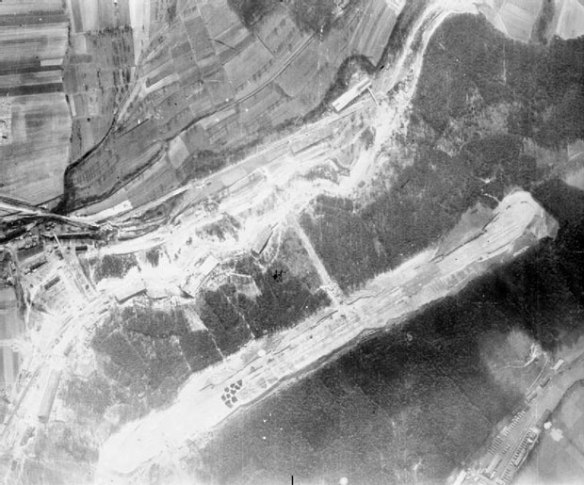Saukel’s project. An aerial photograph of the REIMAHG bombproof factory near Kahla, 26 December 1944. The photograph was included in the target sheet file of this factory. Allied interpreters marked the workshops and tunnel entrance area. Visible at the top is the landing strip constructed on top of the complex (courtesy U. S. National Archives and Records Administration).
The last of the six bombproof factories was the REIMAHG factory in Kahla. On 8 March 1944, Fritz Sauckel, the Reich Plenipotentiary for Labor Mobilization and Gauleiter of Thuringia, suggested to Göring the construction of a massive complex of bombproof factories in the Kahla-Pössneck area, south of Jena. Armaments giant Wilhelm Gustloff Werke teamed with OT and contracted various mining firms in order to construct these factories. Gustloff purchased aircraft producer AGO, whose Oschersleben factory was largely destroyed by American bombing. Then it established a subsidiary firm named REIMAHG (after Reichsmarshall Hermann Göring) to take over production of FW 190 and Ta 152 fighters formerly produced in Oschersleben. Construction began in a former china clay mine dug in a hillside on 11 April 1944. The mine needed relatively little adaptation, including strengthening of weak points, flooring with cement, spraying with concrete against dust, and finally whitewashing. The Jägerstab planned to commence production in August 1944, but in October 1944 the facility was still not ready. The delay has been attributed to the failure to construct a branch railway to the site at an early stage and to Sauckel’s dilettante interventions in the planning and construction process. These allegedly included the removal of the ducted air conditioning system installed by the contractors. By that time Allied intelligence had already identified the factory and determined that it was supposed to produce jets.
Hitler was briefed about the progress of the construction on 21-23 September, and he suggested that a BMW engine production line also be moved to the tunnels Göring and Saur visited the site on 10 October 1944 and two days later Hitler ordered production switched to Me 262. Messerschmitt hurriedly moved production facilities to the factory and began producing there some subcomponents. Since the tunnels were still unfinished this initial production was done in makeshift bunkers constructed on the southern side of the complex. Final assembly began only after some of the tunnels were finished in January 1945. The factory comprised 75 tunnels totaling 32 km in length, offering approximately 30,000 square meters of floor space, and four bombproof buildings with 2-meter-thick walls. Final assembly was supposed to be carried out in one of the bunkers. A special elevator was supposed to deliver completed aircraft to a 1,250-m-long runway on top of the complex, used for test flying and for delivery flights. During early 1945 around 15,000 workers- two-thirds of them slave and foreign workers-worked in the Kahla REIMAHG complex. The slave workers were provided and guarded by an SS watch. At least 3 labor camps were constructed for them around the site. 399 Production, however, never really picked up the pace at REIMAHG and it is estimated that REIMAHG completed only between 15 and 26 aircraft by the time the U. S. Army captured the place on 12 April 1945.
Thus, despite all the monetary investment (estimated at around 30,000,000 RM) and resources invested in this ambitious project, practically nothing came of it. In addition, its unique construction made it very conspicuous to aerial reconnaissance and Allied intelligence easily found it. As the first USSBS team to visit the place summed up, this factory “must have been one of Germany’s less efficient industrial enterprises.” However, REIMAHG definitely represented prevailing late-war thinking regarding armaments production in Nazi Germany. It was also another example of multiple partners’ cooperation in the field of aircraft production. Fritz Sauckel played here a central role in his double function as a local Gauleiter and as the Reich Plenipotentiary for Labor Mobilization, therefore controlling both the territory on which the complex was constructed and the workforce required for its construction.
